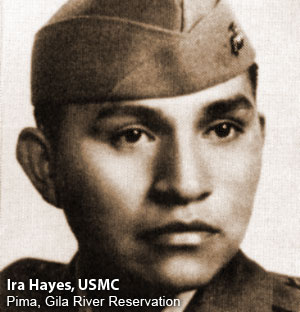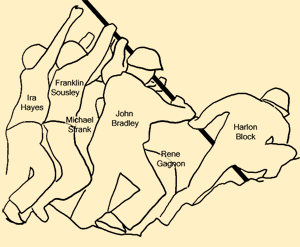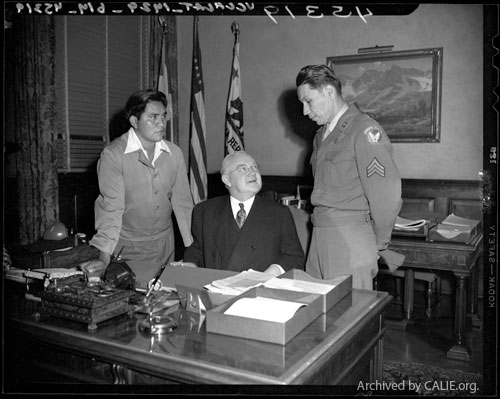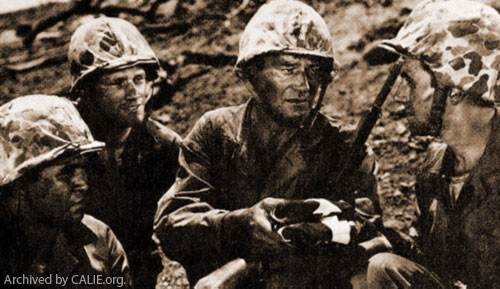 |
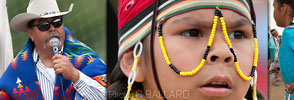 |
 |
Publishing Corner: Indian Community: Science & Wonder Indian Heros: California Indian Art: CALIE Library: Academic Financial Aid: Tribal Governments: Indian Gaming: |
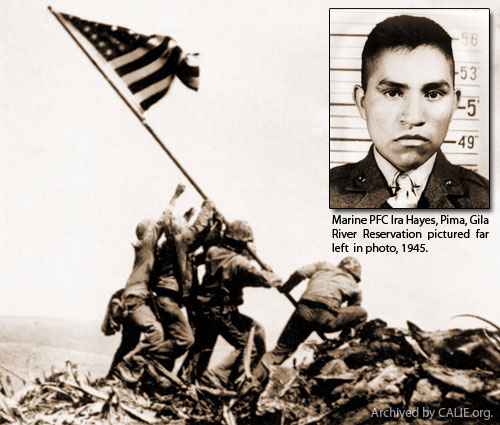
TWENTY TWO YEAR OLD MARINE PRIVATE FIRST CLASS IRA HAYES — first man on left — raises the American flag at the Battle of Iwo Jima in 1945. Famous war photo reenactment: Joe Rosenthal, The Associated Press. Ira Hayes: O’odham USMC Airborne Warrior
Each year, November 10th is the Marine Corps birthday. November 11 is the National USA Veterans day. CALIE.org honors all our military veterans for the freedoms their service has brought to all Americans. Ira Hamilton Hayes trained in San Diego. He was an Akimel O’odham, USMC Airborne Warrior and was a participant in the famous WW II flag raising, February 25, 1945, on Mount Suribachi Iwo Jima. This action resulted in the most identifiable icon associated with the Marine Corps.
Ira Hamilton Hayes, USMC Airborne Warrior was a participant in the famous WW II flag raising, February 25, 1945, on Mount Suribachi Iwo Jima. Ira Hayes was an Akimel O'odham, Pima, Indian, born at Sacaton, Arizona, on 12 January 1923. In 1932, the family moved a few miles southward to Bapchule. Both Sacaton and Bapchule are located within the boundaries of the Gila River Indian Reservation in south central Arizona. Hayes left high school after completing two years of study. He served in the Civilian Conservation Corps in May and June of 1942, and went to work as a carpenter. On 26 August 1942, Ira Hayes enlisted in the Marine Corps Reserve at Phoenix, Arizona for the duration of the National Emergency. Following boot camp at the Marine Corps Recruit Depot at San Diego, Hayes was assigned to the Parachute Training School at Camp Gillespie, Marine Corps Base, San Diego. The Commandant named this small base, dedicated entirely to parachute training, Camp Gillespie in honor of Brevet Major Archibald H. Gillespie, who had participated in the campaign to free California from Mexico in 1846. Ira Hayes graduated one month later, the Akimel Oodham Marine Warrior was qualified as a parachutist on 30 November and promoted to Private First Class the next day. On 2 December, he joined Company B, 3d Parachute Battalion, Divisional Special Troops, 3d Marine Division, at Camp Elliott, California, Then he sailed for Noumea, New Caledonia, on 14 March 1943. In April, Private First Class Hayes' unit was designated Company K, 3d Parachute Battalion, 1st Marine Parachute Regiment. In October Private First Class Hayes sailed for Vella Lavella, arriving on the 14th. Here, he took part in the campaign and occupation of that island until 3 December when he moved north to Bougainville, arriving on the 4th. The campaign there was already underway, but the parachutists had a full share of fighting before they left on 15 January 1944. Hayes was ordered to return to the United States where he landed at San Diego on 14 February 1944, after slightly more than 11 months overseas and two campaigns. The parachute units were disbanded in February, 1945 and Hayes was transferred to Company E, 2d Battalion, 28th Marines, of the 5th Marine Division, then at Camp Pendleton, California. In September, Private First Class Hayes sailed with his company for Hawaii for more training. He sailed from Hawaii in January en route to Iwo Jima where he landed on D-day (19 February 1945) and remained during the fighting until 26 March. On Feb. 23, 1945 to signal the end of Japanese control, Private First Class Hayes and five other's raised the U. S. flag atop Mount Suribuchi on the island of Iwo Jima. The front four are (left to right) Paramarine Ira Hayes, Franklin Sousley, John Bradley and Paramarine Harlon Block.
The back two are Michael Strank (behind Sousley) and Rene Gagnon (behind Bradley). Strank, Block and Sousley would die shortly afterwards. Three of the six men were killed while raising the flag. This heroic act was photographed by Joe Rosenthal (in a reenacment for the photographer), and the photograph transformed Ira Hayes' life for ever. After the flag raising he embarked for Hawaii where he boarded a plane for the U.S. on 15 April. On the 19th, he joined Company C, 1st Headquarters Battalion, Headquarters, U.S. Marine Corps, Washington, D.C. On 10 May, Private First Class Hayes, Private First Class Gagnon, Pharmacist's Mate Second Class Bradley, and Marine Technical Sergeant Keyes Beech, a combat correspondent, left on the bond selling tour. In Chicago, Private First Class Hayes received orders directing his return to the 28th Marines. He arrived at Hilo, Hawaii, and rejoined Company E of the 29th on 28 May. Three weeks later, on 19 June, he was promoted to corporal. With the end of the war, Corporal Hayes and his company left Hilo and landed at Sasebo, Japan, on 22 September to participate in the occupation of Japan. On 25 October, Corporal Hayes boarded his eleventh and last ship to return to his homeland for the third time. Landing at San Francisco on 9 November, he was honorably discharged on 1 December. Corporal Hayes was awarded a Letter of Commendation with Commendation Ribbon by the Commanding General, Fleet Marine Force, Pacific, Lieutenant General Roy S. Geiger, for his "meritorious and efficient performance of duty while serving with a Marine infantry battalion. This commendation is awarded for duty during operations against the enemy on Vella Lavella and Bougainville, British Solomon Islands, from 15 August to 15 December 1943. Also for performance of duty on Iwo Jima, Volcano Islands, from 19 February to 27 March 1945." The list of the Corporal's decorations and medals includes the Commendation Ribbon with "V" combat device, Presidential Unit Citation with one star (for Iwo Jima), Asiatic-Pacific Campaign Medal with four stars (for Vella Lavella, Bougainville, Consolidation of the Northern Solomons, and Iwo Jima), American Campaign Medal, and the World War II Victory Medal. The Airborne Marine died at Bapchule on 24 January 1955. He was buried on 2 February 1955 at Arlington National Cemetery, in Section 34, Plot 479A. USMC Airborne history began as early as 1927, 12 Marines parachuted from an aircraft at NAS Anacostia, Washington D.C.; how ever, there were no organized Marine parachute units at that time. German success with airborne forces in the early days of WW 11 prompted every major military in the world to explore the new concept - and that included the U. S. Marine Corps. MGen. Holcomb, Commandant of the Marine Corps, ordered plans for the development of a Marine parachute program in May 1940. Requirements were set for one battalion of parachutists for every Marine regiment. Each battalion was to be equipped with two 75 mm-pack howitzers, three days of rations, hand-drawn vehicles, and light antiaircraft and anti tank weapons. Three tactical scenarios were envisioned for the parachute battalions: as a reconnoitering and raiding force; as a spearhead or advance guard to hold strategic objectives until the arrival of larger forces; and as an independent force operating in the guerrilla role for extended periods. During the summer of 1940, the Marine parachute program gained impetus after Marine officers observed the Army's airborne training and facilities as well as the receipt of additional reports of the use of airborne troops in Europe. The first class of two officers and 38 enlisted men began training at NAS Lakehurst, New Jersey on October 26, 1940. Tower training was accomplished at the Army's facility at nearby Hightstown, New Jersey. Live jumps were made at Lakehurst. The second class began training on December 30, 1940. A total of 225 Marines completed the Lakehurst course. Due to the inadequacy of the facilities at Lakehurst and the unavailability of the Army's towers at Hightstown, Capt. Marion Dawson and the second class of parachutists were sent to San Diego in February 1941 to set up an additional school. The third class of parachutists was also sent to San Diego and eventually formed the 2nd Parachute Battalion. The U.S. Navy acquired 612.656 acres of land in Santee, California, on 31 March 1942 for the Marine Parachute School. This land was acquired from private land owners via condemnation proceedings and a Declaration of Taking. Another 75.2 acres of land were acquired by the Navy on 4 September 1942 for the Marine Parachute School also via a Declaration of Taking, making a combined total of 687.856 acres. The Marine Parachute School was located between the city centers of Santee and El Cajon, about 15 miles northeast of downtown San Diego in San Diego County, California. Site improvements consisted of two aircraft runways, aircraft parking aprons, a flight control tower, three parachute jump towers, a parachute loft, parachute training building, barracks, storehouses, garage, mess hall, squadron shops, hangar, fire house, swimming pool, rifle range, water and sewage treatment plants, and other facilities. Parachute trainees undergo their initial training at San Diego. This included leaps from platforms to practice the proper landing technique. Department of Defense Photo (USMC) 127-GC-121-402906 The school initially operated out of San Diego's Camp Elliott, but the Corps built barracks, jump towers, plane mockups, and aviation fields near Santee and moved the entire operation there at the end of August 1942. During the 16 months of Camp Gillespie's existence, a total of 3,000 parachutists graduated without a single fatality. Up to July 1943, 20,000 jumps had been made at Gillespie. Marine parachute battalions fought in several campaigns in the South Pacific including Guadalcanal, but no combat parachute drops were ever made. When the program cancelled, the parachutists present at San Diego joined the 5th Marine Division and eventually took part in the invasion of Iwo Jima. One of the former parachutists was Ira Hayes, the American Indian who raised the flag on Mount Suribachi. Today, the Marines train a small number of parachutists - primarily for reconnaissance operations. The U.S. Navy acquired the site on 31 March 1942, and 75.2 additional acres acquired on 4 September 1942. The site was originally used as a Marine parachute school. The Marine Parachute School operated from 1942 until 1944. In February 1944, the Parachute School and all of its facilities became an auxiliary airfield for the U.S. Marine Corps Air Station, El Toro, California. Site was named Camp Gillespie at this time. Aircraft and Air Warning Squadron operated the airfield until 1947. Acres deeded to the County of San Diego in 1953.
WAR HEROES: Ira Hayes, left, a Pima Indian survivor of the Mt. Suribachi Flag-raising, and Sgt. Henry Reed, Indian veteran of Bataan Death March, call on Los Angeles Mayor Fletcher Bowron to protest laws that discriminated against Native American housing rights. Airborne Warrior Ira Hayes is an important part of San Diego’s military and American Indian history. From his USMC training at the Marine Corps Recruit Depot, San Diego, Hayes was assigned to the Parachute Training School at Camp Gillespie, Marine Corps Base, San Diego. After deployment in the Pacific, 11 months overseas and two campaigns, he was assigned to the 5th Marine Division, then at Camp Pendleton, California before Iwo Jima. We honor his service. Aho.
HELP CONTRIBUTE to this section To help contribute to this page please CONTACT the webmaster to contribute your information, links research for publication. |
CALIF INDIAN EDU NETWORK: AHMIUM.org | SDICENTER.org | APAPAS.com
—
WEB SITE DESIGN
www.calie.org COPYRIGHT 2008-Present • ALL RIGHTS RESERVED


